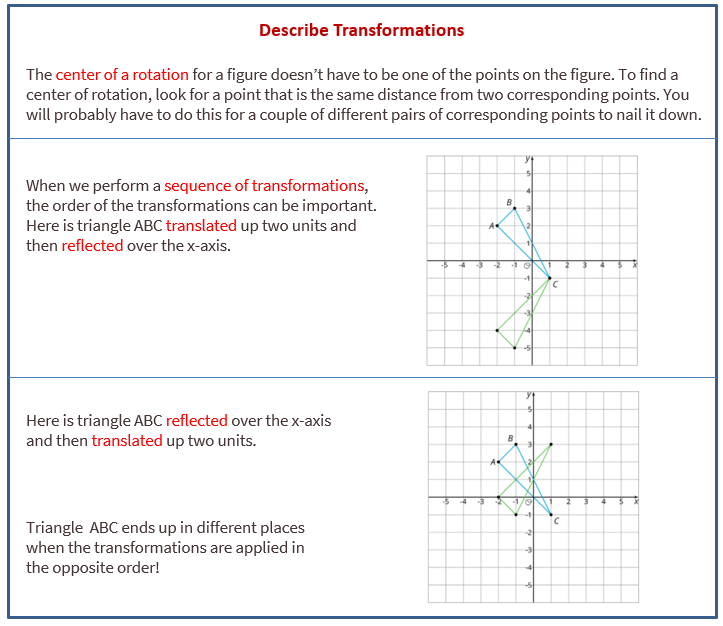Illustrative Mathematics Grade 8, Unit 1, Lesson 6: Describing Transformations
Learning Targets:
- I can apply transformations to a polygon on a grid if I know the coordinates of its vertices.
Related Pages
Illustrative Math
Grade 7
Lesson 6: Describing Transformations
Let’s transform some polygons in the coordinate plane.
Illustrative Math Unit 8.1, Lesson 6 (printable worksheets)
Lesson 6 Summary
The following diagram shows how to apply transformations to a polygon on a grid.

Lesson 6.1 Finding a Center of Rotation
Andre performs a 90-degree counterclockwise rotation of Polygon P and gets Polygon P’, but he does not say what the center of the rotation is. Can you find the center?
Lesson 6.2 Info Gap: Transformation Information
Your teacher will give you either a problem card or a data card. Do not show or read your card to your partner.
If your teacher gives you the problem card:
- Silently read your card and think about what information you need to answer the question.
- Ask your partner for the specific information that you need.
- Explain to your partner how you are using the information to solve the problem.
- Solve the problem and explain your reasoning to your partner.
If your teacher gives you the data card: - Silently read the information on your card.
- Ask your partner “What specific information do you need?” and wait for your partner to ask for information. Only give information that is on your card. (Do not figure out anything for your partner!)
- Before telling your partner the information, ask “Why do you need that information?”
- After your partner solves the problem, ask them to explain their reasoning and listen to their explanation.
Pause here so your teacher can review your work. Ask your teacher for a new set of cards and repeat the activity, trading roles with your partner.
Are you ready for more?
Sometimes two transformations, one performed after the other, have a nice description as a single transformation. For example, instead of translating 2 units up followed by translating 3 units up, we could simply translate 5 units up. Instead of rotating 20 degrees counterclockwise around the origin followed by rotating 80 degrees clockwise around the origin, we could simply rotate 60 degrees clockwise around the origin.
Can you find a simple description of reflecting across the x-axis followed by reflecting across the y-axis?
Lesson 5 Practice Problems
- Here is Trapezoid A in the coordinate plane:
a. Draw Polygon B, the image of A, using the y-axis as the line of reflection.
b. Draw Polygon C, the image of B, using the x-axis as the line of reflection.
c. Draw Polygon D, the image of C, using the x-axis as the line of reflection. - The point (-4,1) is rotated 180 degrees counterclockwise using center (-3,0). What are the coordinates of the image?
A. (-5,-2)
B. (-4,-1)
C. (-2,-1)
D. (4,-1) - Describe a sequence of transformations for which Triangle B is the image of Triangle A.
- Here is quadrilateral ABCD.
Draw the image of quadrilateral ABCD after each transformation.
a. The translation that takes B to D.
b. The reflection over segment BC.
c. The rotation about point A by angle DAB, counterclockwise.
The Open Up Resources math curriculum is free to download from the Open Up Resources website and is also available from Illustrative Mathematics.
Try out our new and fun Fraction Concoction Game.
Add and subtract fractions to make exciting fraction concoctions following a recipe. There are four levels of difficulty: Easy, medium, hard and insane. Practice the basics of fraction addition and subtraction or challenge yourself with the insane level.

We welcome your feedback, comments and questions about this site or page. Please submit your feedback or enquiries via our Feedback page.